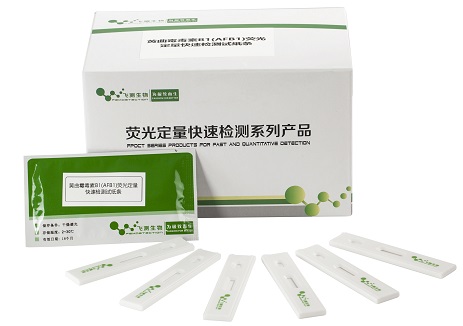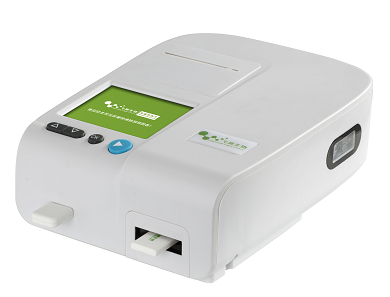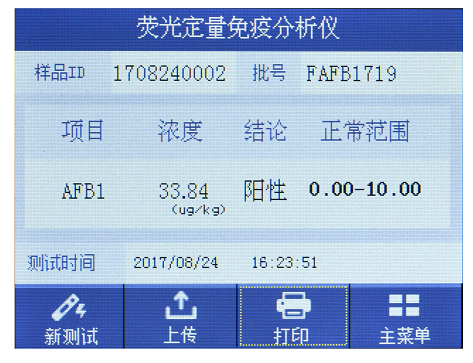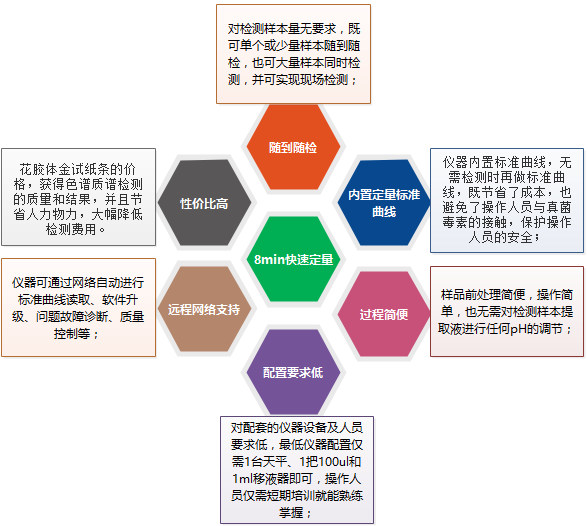Contamination and rapid quantitative detection of mycotoxin in tea - accurate quantification in -8min
I. Overview of mycotoxins Mycotoxins are secondary toxic metabolites that are produced by certain fungi under certain environmental conditions and endanger humans and animals. More than 400 mycotoxins have been discovered to date, mainly aflatoxin, ochratoxin A, patulin, trichothecene toxin, deoxynivalenol and T-2 zearalenone, fumonisin , leucomycin, citrinin and the like. Mycotoxins are mainly produced by Aspergillus, Penicillium, Alternaria and Fusarium. These microorganisms are widely distributed in plants, soil and air, and may contaminate plant foods such as grains, soybeans, nuts, fruits, seasonings, cocoa, coffee, Chinese herbal medicines and their products (such as grapes, beer), feed, and the like. It may also contaminate food or feed in the raw materials, processing, storage, etc., and thus enter the food chain. According to FAO statistics, 25% of the world's cereals are contaminated with mycotoxins every year, resulting in an average annual loss of US$9.32 billion. In addition, mycotoxins in cereals and nuts may be the most important insecurities in foods faced by consumers in Africa, Asia and South America. 2. What mycotoxins are present in tea? In recent years, the contamination of mycotoxins in tea, such as Pu'er tea, which has been fermented by microorganisms, has attracted the attention of consumers. Tea refers to the dry and tender leaves and tender stems of tea trees. It has become the world's most consumed beverage in addition to water. Its safety is especially important for the health of consumers and the development of the tea industry. Toxic fungi are widely distributed, tea garden soil and processing workshops may exist, and tea processing may be contaminated by toxin-producing fungi. Although the drying process may kill most of the microorganisms in black tea and green tea, if it is packaged and stored improperly after drying, especially after the moisture absorption and moisture of the tea leaves, it may be contaminated by fungi and mycotoxins. However, the post-fermentation process of black tea such as Pu'er tea and 茯 brick tea and the presence of various fungal strains such as Aspergillus and Penicillium may also be contaminated by mycotoxins. However, at present, only India has made a limited regulation (30ug/kg) for aflatoxin in black tea. GB2761-2017 does not stipulate the limit of mycotoxin in tea products. 2.1. Related research on mycotoxin of black tea Black tea refers to the tea products produced by the fresh leaves of tea trees through the steps of withering, licking, fermenting and drying. It is the world's largest tea category and the main consumer variety except China and Japan. Therefore, it is currently contaminated with black tea. There are relatively many reports on toxins. As early as 1974, Japanese scholar Hitokoto et al. conducted research on the contamination of tea toxin-producing bacteria in Tokyo. From the 19 samples of black tea sold in Tokyo, 259 strains of Aspergillus awamori were isolated and found to be cultured in yeast sucrose. The koji kojimycin was produced on the base, indicating that the black tea was contaminated by the toxin producing bacteria. Abdel-Hafez et al. used thin-layer chromatography to find that 4 samples of black tea powder were contaminated with aflatoxin B1 and B2, and the content was 2.8~2.17 mg/kg. Hasan et al. isolated a number of strains of Aspergillus flavus from 20 brands of black tea powder sold in Egypt. It was found that 15 of them can produce aflatoxins B1, B2, G1 and G2, and 5 strains can produce aflatoxins B1 and B2; further The study found that aflatoxin can be produced after inoculation of tea-producing strains, and the toxin content increases with the increase of water content; the tea water content is 45%, 28 °C, and the toxin content is the largest under the condition of culture for 20 days, up to 26~ 81ug/kg. Elshafie et al. isolated and identified five fungi from 48 samples of black tea purchased from four brands in Muscat. Further detection showed that 25 strains of Aspergillus flavus did not produce aflatoxin. Ostry et al. detected a strain of Aspergillus flavus that may produce aflatoxin in black tea. Martins et al. found that 16 of the 18 black tea samples purchased in Lisbon contaminated fumonisin B1 at 80-280 mg/kg and did not detect fumonisin B2. According to Miraglia, 139 samples of black tea were tested in the EU countries from 1995 to 1998, and 8 of them were positive for ochratoxin A, with a content of 0.03 to 10.3 μg/kg. Hasan found that the aflatoxin in the decaffeinated black tea was five times that of the regular tea after inoculation with the Aspergillus flavus strain. An analysis by Rẽezác found that 10 samples of black tea sold in Prague were contaminated by fungi, but in line with Czech standards, the toxigenic test showed that the isolated fungus did not produce aflatoxin. Santos et al. used a combination of enzyme-linked immunosorbent assay to detect aflatoxin, ochratoxin A, zearalenone, deoxynivalenol in 84 medicinal or aromatic plants, including black tea, in Spain. , T-2 toxin, citrinin and fumonisin, the samples were found to be generally contaminated with toxins. Mogensen et al found that Aspergillus acidus isolated from black tea did not produce ochratoxin A, fumonisins B2 and B4. Monbaliu et al. established an ultra performance liquid chromatography-tandem mass spectrometry method for simultaneous determination of 27 mycotoxins, and tested 91 tea samples. Only one sample detected fumonisin B1 (76ug/kg). The study found that the amount of fungi and the content of toxins in black tea are related to the water content. After the tea is damp, the fungus will multiply and produce toxins. Fungal spores may contaminate tea products such as black tea and green tea in many aspects of processing. However, if the fungus grows and produces toxins, it needs a certain amount of water. If the tea leaves are dry and the storage process is not affected by moisture, even if the tea contains fungal spores, it will not multiply. No mycotoxins are produced. Therefore, for tea processing enterprises such as black tea and green tea, the risk of mycotoxin contamination can be reduced or eliminated by thoroughly drying, timely packaging or vacuum packaging, storage and transportation without moisture. For tea consumers, after opening the package, check whether the tea is mildewed. The tea after opening must be stored dry, do not drink mildewed tea, and avoid the harm of mycotoxins. 2.2. Black tea mycotoxins research Black tea refers to the production process of fresh leaves, which are killed, simmered, simmered (post-fermented), dried, and the finished tea is oil black or dark brown. There are mainly Yunnan Pu'er Tea, Hunan Brick Tea, Sichuan Kang Brick Tea, and Guangxi Liubao Tea. Due to its unique quality and good health benefits, black tea production and consumption have gradually increased in recent years. However, black tea processing such as Pu'er tea has a post-fermentation process involving a variety of microorganisms, which may produce toxins. For example, Aspergillus niger, a dominant strain of Pu'er tea fermentation, is generally recognized as a safe microorganism. However, in recent years, some strains of Aspergillus niger have been found to produce ochratoxin and fumonisin; some bacteria of the genus Aspergillus sp. Mycotoxins such as ochratoxin and fumonisin can also be produced. At present, the risk of mycotoxin contamination of black tea has caused widespread concern, and some scholars have carried out related research. Hitokoto et al. analyzed a total of 11 tea samples, 2 of which were Pu'er tea samples. The most common fungi were found in Pu'er tea. The dominant bacteria were Aspergillus variabilis and Aspergillus megacephala. One strain of Aspergillus variabilis produced miscellaneous on wheat medium. Aspergillus, but no toxin was produced in green tea; polymyxin did not produce toxins on glucose yeast and wheat medium. Chen Qiuyi analyzed 44 samples of Pu'er tea sold in Taiwan, and did not detect aflatoxin, ochratoxin A, leucomycin and citrinin. Meanwhile, Chen Qiuzhen also studied the toxin production of Aspergillus flavus in the fermentation of Pu'er tea. No aflatoxin was detected in the fermented samples of the unfermented strain of Aspergillus flavus and the fermented samples of the non-sterilized tea inoculated with Aspergillus flavus; the samples of the sterilized tea inoculated with the Aspergillus flavus strain detected aflatoxin (1.05 ug). /kg), this study shows that normal Pu'er tea fermentation process does not produce aflatoxin. Abe et al. used HPLC assay to find that Aspergillus niger isolated from Pu-erh tea did not produce ochratoxin A and fumonisin. Mogensen et al found that Aspergillus acidus isolated from Pu'er tea samples did not produce ochratoxin A, fumonisins B2 and B4. HOU and other tests found that tea samples fermented with Aspergillus niger and A. carbonarius did not contain ochratoxin A and fumonisin. Chen Jianling and other random samples of 70 samples of Pu'er tea stored in a wet market in a tea market in Guangzhou, and found 8 samples (11.43%) aflatoxin B1>5μg/kg, 63 samples (90%) deoxynivalenol Contamination > 1 mg/kg, both fumonisin (B1 and B1) and T-2 toxin levels are less than 1 mg/kg and 100 μg/kg, respectively, but can be detected in the sample, which should be widely considered. ZHANG et al. were detected by immunochromatography and verified by high performance liquid chromatography-mass spectrometry (HPLC-MS). It was found that 5 samples of Pu'er tea contained aflatoxin, and the content was 4.9-59.3 μg/kg. Liu Qifang was determined by enzyme-linked immunosorbent assay kit. It was found that 10 (16.6%) of the aflatoxin contamination level of Pu'er tea exceeded 20 μg/kg, and 13 of the deoxynivalenol contamination level exceeded 1000 μg/kg (23.0). %); Zearalenone, fumonisin, ochratoxin, and T-2 toxin were detected in the samples. Haas et al tested 36 samples of Pu'er tea, aflatoxins (B1, B2, G1 and G2) and fumonisin (B1, B2 and B3) were not detected, and ochratoxin A was detected in 4 samples. It is 0.65 to 94.7 μg/kg. Zhao Haojun and other samples were used to detect 2 samples of commercially available Pu-erh tea, and no aflatoxin B1 was detected. Chen Qiu's research on the fermentation of Pu'er tea by Aspergillus flavus strain showed that the normal Pu'er tea fermentation process did not produce aflatoxin, and three independent studies such as Abe et al, Mogensen et al. and HOU showed that the Aspergillus species in the fermentation process of Pu'er tea did not. Ochratoxin A and fumonisin are produced. All of the above studies have shown that normal Pu'er tea fermentation does not produce mycotoxins. Reports on the detection of mycotoxins in Pu'er tea products are inconsistent due to differences in samples and methods of measurement. Pu'er tea samples tested by Chen Jianling, ZHANG et al. and Liu Qifang were heavily contaminated with aflatoxin, deoxynivalenol, fumonisin and T-2 toxin; while Chen Qiuzhen and Zhao Haojun tested 44 and 2 respectively. Commercially available Pu'er tea samples, no toxins were detected. Haas et al. analyzed 8 mycotoxins from 36 samples and ochratoxin A was detected in only 4 samples. In recent years, the mycotoxin contamination of black tea has caused widespread concern. It is necessary to strengthen the process control to detect whether the fungus produces toxins during the fermentation process; to screen and apply the toxin-producing strains to ferment and monitor the production of poison, and establish a safe black tea fermentation technology system. 2.3. Study on other tea mycotoxins There are few studies on mycotoxins in green tea and white tea. Only the fungi isolated from 10 Czech green tea samples, such as Reezácˇová, found no aflatoxin. Santos et al. tested samples of green tea and white tea commercially available in Spain and found that some of the samples were contaminated with aflatoxin, ochratoxin, zearalenone, deoxynivalenol, T-2 toxin and citrinin . Zhao Haojun and other two green tea samples were tested and no aflatoxin B1 was detected. In summary, black tea, black tea, and green tea may be contaminated with mycotoxins. Drinking tea contaminated with mycotoxins is not good for health. On the other hand, there are also a large number of literature studies showing that green tea, black tea, and Pu'er tea all have a "detoxification" effect, which can reduce the toxicity of mycotoxins such as aflatoxins. Therefore, risk assessment studies of mycotoxin in tea should be carried out in the future to accurately assess the risk of mycotoxin in tea. There are many types of tea processing technology and products in China, and there are many manufacturers, and most of them are not large. Therefore, it is necessary to pay attention to the situation that tea may be contaminated by toxins. It is recommended to carry out research on the detection of mycotoxin in different varieties of tea products, and to investigate the contamination of various tea products by mycotoxin, and to establish a limit indicator of toxins according to the contamination of mycotoxins. For teas that have microbes involved in fermentation (such as black tea), safe fermentation techniques are established by applying non-toxin-producing strains to ferment and monitoring toxins in the fermentation process. China's tea enterprises and regulatory agencies should strengthen the process control and monitoring of tea toxins to reduce the risk of tea contamination by mycotoxins to ensure safe drinking. Third, the Shanghai Biological test flying tea mycotoxin rapid quantitative detection scheme --8min accurate quantitation Based on the leading fluorescence quantitative FPOCT technology platform, Shanghai Festo Biotech is the first to introduce six common fungal toxin fluorescence quantitative detection systems, including mycotoxin detector and mycotoxin fluorescence quantitative detection strip, which can be quickly and accurately quantified in 8 min. The detection of the residual content of mycotoxins in tea leaves, the sample preparation is simple, the detection operation is simple, the results are accurate and reliable, and can be printed on site. The accuracy is in accordance with the detection results of HPLC method, and is suitable for various tea processing enterprises, third-party testing institutions and Government regulatory agency. 3.1. Shanghai fly test biomycotoxin fluorescence quantitative test strip performance 3.2. Taking the detection of aflatoxin B1 in tea as an example: Fluorescence quantitative rapid detection system performance of aflatoxin B1 Detection sensitivity: 0.5 μg / kg; Quantitative linear range: 1.0 μg / kg - 75.0 μg / kg; Sample preparation time: 7min; Detection time: 8min; Accuracy: recovery rate is 80%-125%; Specificity: no cross-reactivity with other mycotoxins at a concentration of 1000 μg/kg; 3.3. Sample preparation process 1. Crushing (tea sample crushing treatment); 2. Oscillation extraction (5min); 3. Centrifugation (2min); 3.4. Detection operation process 1, dilution; 2. Adding reaction (8min); 3, reading, print test report; 3.5. Results interpretation and output Reading with a portable aflatoxin detector makes the test results more accurate and objective, avoiding human error. The test result will be presented on the liquid crystal display of the fluorescence reader. At the same time, the paper test report can be obtained by pressing the print button. In addition, after the WIFI data upload function of the instrument is turned on, the relevant data information will be automatically uploaded to the “Food Safety Traceability Managementâ€. Cloud platform for easy traceability and quality management. 3.6. Shanghai fly test biomycotoxin series fluorescent quantitative test strip product highlights The Network Camera/ Network IR Camera/ Network Cameras/ Network Camera HD/ IP Camera Wifi/ IP Cameras/ Mini IP Cam, also called the IPC, WEBCAM, or WEB Camera, is a new-generation camera that combines the traditional camera and the network technology. And the user can monitor the Network Camera images just with a standard web browser (such as the "Microsoft IE or Netscape).
The design of the world's first Network Camera is originated from two scientists who wanted to drink coffee.
In 1991, only the main computer room of the Cambridge University Computer Research Center had a coffee maker. From time to time, scientists from other rooms ran to the main computer room but found that the coffee was drank up. In order to solve the problem of a wasteful trip when pouring coffee, scientists Fraser and Paul thought of assembling a device that can monitor the coffee maker in the main room. They first pointed a camera at the coffee maker, set to take three photos per minute, and then wrote a program to send the camera pictures to the research department`s internal network. Then, the Cambridge University successfully installed the first Network Camera in the world.
Network IR Camera, Network Cameras, IP Cameras, Mini IP Cam,4G Camera.WIFI Camera.IP Camera.IP Cam system.IP Cam SHENZHEN SANAN TECHNOLOGY CO.,LTD , https://www.sanan-cctv.com







As a new generation product that combines the traditional camera and the network video technology, in addition to the image capturing function of the traditional cameras, the Network Camera also has a built-in digital compression controller and a WEB-based operating system; which makes the video data compressed and encrypted, and then delivered to the end users via the local area network, internet or wireless network. The remote user can use a standard web browser on the PC to access the network camera according to the IP address of the network camera, monitor the on-site situation of the target site, edit and store the image data, and can even control the camera PTZ and lens to achieve the monitor in all directions.
Nowadays, the Network Camera are being used more and more widely. So do you know how the Network Camera was invented? Well, here is a story.
On November 22nd, 1993, the real "Internet camera" was born and it was still in the computer research department of the Cambridge University. The laboratory which another scientist named Johnson was at could not be connected to the internal network. Johnson could not use the previous monitoring software to check the coffee, so he wrote a program to make his own computer can receive photos from the camera; which makes the breakthrough of the camera from the internal network to the World Wide Web, realized.
Since then, millions of people from all over the world have joined the "coffee pot watching activity" through the Internet. In 2011, due to the obsolete equipment and the inability to maintain it, Cambridge computer scientists finally shut down the Network Camera.

